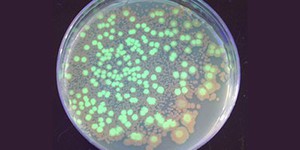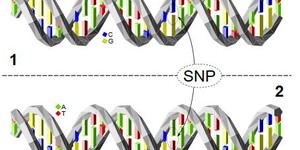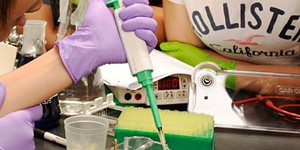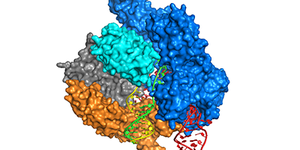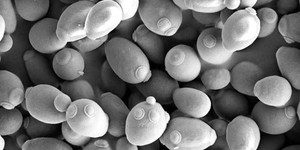Ninth Grade, Genetic Engineering Science Projects (6 results)
Genetic engineering, also called gene editing or genetic modification, is the process of altering an organism's DNA in order to change a trait. This can mean changing a single base pair, adding or deleting a single gene, or changing an even larger strand of DNA. Using genetic engineering, genes from one organism can be added to the genome of a completely different species. It is even possible to experiment with synthesizing and inserting novel genes in the hopes of creating new traits.
Many products and therapies have already been developed using genetic engineering. For example, crops with higher nutritional value, improved taste, or resistance to pests have been engineered by adding genes from one plant species into another. Similarly, expression of a human gene in yeast and bacteria allows pharmaceutical companies to produce insulin to treat diabetic patients. In 2020, scientists had their first successful human trial with CRISPR (a genetic engineering technique), to correct a mutant gene that causes sickle cell anemia, a painful and sometimes deadly blood disease.
There are many different genetic engineering techniques, including molecular cloning and CRISPR, and new techniques are being developed rapidly. Despite this variety, all genetic engineering projects involve carrying out four main steps:
- Identifying the trait to be introduced, eliminated, or otherwise modified.
- Determining what piece of DNA needs to be added or removed in order to get the desired trait modification.
- Making the physical modifications to the organism's DNA.
- Verifying that the trait has been modified as desired.
Learn more about genetic engineering, and even try your hand at it, with these resources.
|
Select a resource
Sort by
|
Have you ever heard or read about GMO?
GMO stands for
genetically modified
organisms.
Scientists can deliberately modify the DNA of organisms, such as bacteria or plants, to change their properties for a specific purpose. For example, crops can be modified to become more drought- or pest-resistant. Genetic engineering is a very powerful tool in biotechnology that has already found many different applications in agriculture, medicine, and industry. In this project, you will engineer a…
Read more
Our genes are made up of hundreds to millions of building blocks, called DNA nucleotides, and if
just a single nucleotide of DNA becomes mutated it might cause a devastating genetic disease. But
sometimes a mutation actually does no damage. What kinds of mutations have to occur to cause a genetic disease?
In this science project, you will explore online genetic databases to identify how a mutation in a gene
can result in a dysfunctional protein, and how other mutations may have no effect…
Read more
New
Artificial intelligence (AI) programs can now generate photorealistic pictures of people who do not exist in the real world. How can you tell if a picture is of a real person or a fake, AI-generated person? What features of the picture do people use to decide whether the face is real or AI-generated? In this project, you will explore these questions as you ask volunteers to look at both real and AI-generated pictures of human faces.
Read more
Genetically modified organisms (GMOs) are organisms whose DNA have been manipulated to give them new traits. In genetically modified (GM) food crops traits like resistance to drought or pesticide might be added, or the crop may have been made more nutritious, or the taste may be altered to give you something like the impossible burger. Are there GMOs in your favorite foods? Many countries have implemented or are in the process of implementing GMO labeling on foods, but with a little bit of…
Read more
Many scientists are currently very excited about CRISPR, as it has the potential to revolutionize gene editing. But what exactly is CRISPR and what does it do? CRISPR is a novel tool in gene editing that allows the modification of genetic DNA at specific target sites in many different organisms. Researchers have high hopes that this technology can, one day, cure genetic diseases, as mutated DNA sequences can easily be corrected. In this project, you will use CRISPR to mutate a DNA sequence…
Read more
Can you imagine a glowing loaf of bread? You might not be able to make the whole loaf glow, but you can get baker's yeast to fluoresce! The way to do this is to modify the genetic information of the yeast organism. The technology that is used to do this is called genetic engineering. With genetic engineering, you can insert a fluorescent protein gene from a jellyfish into yeast cells, so they start glowing under blue light! Do this project to see for yourself!
Read more
New
Have you ever noticed that on a hot day, it's more comfortable to wear a light-colored shirt than a dark one? Or that it's cooler in a park than walking down a street? This happens because different surfaces absorb and reflect heat in different ways. Urban heat islands are parts of cities where man-made surfaces like pavement and buildings replace natural surfaces like grass and trees. In this project, you will use temperature and satellite data to see if certain areas in a city have higher…
Read more
What is expression cloning and how is it used in the biotechnology industry? How are plasmids constructed for use in a bacterial expression system? You can investigate these questions and more using bacterial expression kits meant for high school classes. You will need a laboratory space equipped to grow bacteria and carry out simple molecular biology. A kit with plasmids and bacterial cells to transform are also needed. Here are two possibilities:
BioBuilder What a Colorful World Kit …
Read more
|


